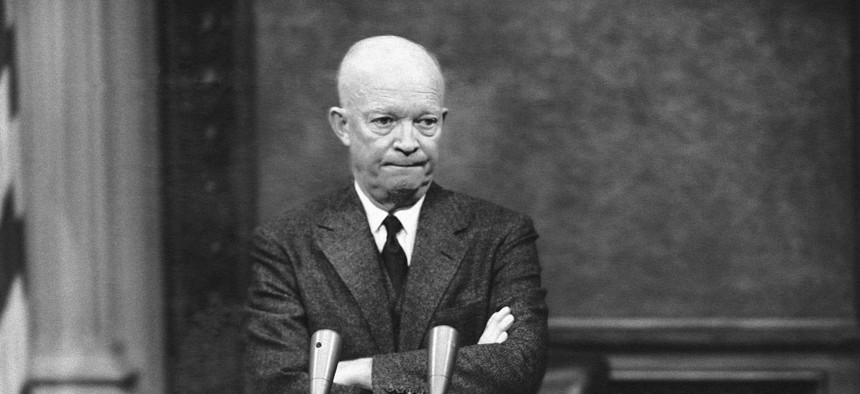
President Dwight Eisenhower, tight- lipped and standing with folded arms, is thoughtful in Washington, D.C., Jan. 19, 1956. AP
America Has Come Full Circle in the Middle East
“We are opening a Pandora’s Box,” Dwight Eisenhower warned when he ordered the first U.S. combat mission in the region. Little did he know how right he would be.
In 1958, U.S. leaders stood at the threshold of an American era in the Middle East, conflicted about whether it was worth the trouble to usher in.
A year earlier, in the context of the emergent Cold War and fading British and French power in the region, Dwight Eisenhower had articulated and received congressional approval for what became known as the Eisenhower doctrine. The United States had for the first time staked out national interests in the Middle East—oil, U.S. bases and allies, Soviet containment—and declared that it was prepared to defend them with military force.
Sixty-two years before President Donald Trump dispatched a drone to Baghdad to kill Iranian General Qassem Soleimani, this is how American combat missions in the post–World War II Middle East began.
Eisenhower felt compelled to issue his doctrine following a showdown over the nationalization of the Suez Canal by Egyptian President Gamal Abdel Nasser, an Arab nationalist whom U.S. officials perceived as allied with the Soviet Union. The U.S. president had pledged to honor requests for American military assistance by countries facing aggression from proponents of “international communism.”
Related: The Blueprint Iran Could Follow After Soleimani’s Death
Related: How America Fell Out of Love With the ‘Forever Wars’ - The Atlantic
Related: Iran Is Acting Like the International Villain of Trump’s Prophecy
That U.S. commitment was tested when insurrectionist Iraqi army officers executed their country’s last king, the Western-friendly Faisal II, in Baghdad in the summer of 1958. Camille Chamoun, the Christian leader of Lebanon and an opponent of Nasser, asked for American aid against the backdrop of the coup in Iraq and looming civil war in his own country. (The revolution in Iraq had little connection to Nasser, but the U.S. didn’t initially grasp that.) In keeping with the grand domino theorizing of that period, U.S. officials worried that if they didn’t act decisively, U.S. partners such as Lebanon and Jordan would be next to fall to Nasserite nationalism and, by extension, Soviet communism.
Eisenhower hastily convened a meeting with his top national-security advisers on the day of the Iraqi king’s downfall. John Foster Dulles, a consummate Cold Warrior and the U.S. secretary of state at the time, argued that a failure to heed Chamoun’s call would signal to the Soviets that the United States wasn’t ready to take risks for its allies, and would thus mean “the decline and indeed the elimination of our influence—from Indonesia to Morocco.” In a calculation that has been turned on its head today, the president maintained that “to lose this area by inaction would be far worse than the loss in China, because of the strategic position and resources of the Middle East.” His team insisted that the U.S. was on sound footing to intercede militarily in another country’s civil war, because Lebanon’s president had invited them in, a poignant point to read today as Iraqi officials seek to kick the U.S. military out of the country in retaliation forSoleimani’s killing. As for intervening in Iraq as well, Eisenhower, a celebrated World War II general who was typically cautious about taking military action, dismissed the notion as unworkable. In an illustration of just how new all this was to Americans, Eisenhower’s speech announcing the operation included a geography lesson, noting that Lebanon was “a small country, a little less than the size of Connecticut” and that Iraq was “nearby.” He was also mindful of the risks. “I realize we are opening a Pandora’s Box here,” a jumpy Eisenhower told Britain’s equally nervous prime minister on the eve of deploying the Marines to Lebanon.
The episode and its aftermath are essential to understanding how the United States went from being deeply apprehensive about getting involved militarily in the Middle East to conducting more military interventions there than in any other region in the world. The trajectory of U.S. involvement is one of American leaders gradually putting stock in their ability to achieve their objectives through discrete military action and then investing everything in costly military misadventures, to the point that we’ve come full circle: The American public and its leaders are profoundly ambivalent about even limited and critical missions, such as the campaign against the Islamic State in Iraq and Syria.
Even in 1958, now-familiar patterns of military intervention in the Middle East were evident. Though he advocated for a troop deployment to Lebanon, for example, Dulles warned that the United States was entering a situation in which “it will be easy to get ourselves involved, and very hard to get out.” Then, as now, military inaction was equated with the United States renouncing its interests in the region. “We must act [in Lebanon], or get out of the Middle East entirely,” Eisenhower told his aides, presenting a stark choice that Trump is surely acquainted with. Then, as now, the White House debated whether it needed congressional authorization for its combat operations. Then, as now, U.S. leaders offered the public misleading justifications for their use of force; Eisenhower greatly inflated the situation in Lebanon to be about avoiding another world war by refusing to appease the Soviet Union, when it mostly had to do with internal Lebanese politics.
Despite Eisenhower’s soaring rhetoric, the actual U.S. objective was narrow in scope: to prop up a friendly government. And that goal was achieved with surprising ease. Dulles had predicted that the military intervention would generate blowback, such as an oil crisis as Egypt and its ally Syria retaliated against commercial infrastructure, or “a wave of anti-Western feeling in the Arab world.” Yet when hundreds of U.S. marines came ashore in Beirut on July 15, 1958—backed up by three aircraft carriers and dozens of warships in the Mediterranean Sea, plus the threat of the U.S. deploying nuclear weapons from Germany—they were greeted merely by sunbathers and vendors on the beach. U.S. diplomats soon negotiated a political settlement that eased Chamoun out of power. American forces, eventually numbering in the thousands, left the country in October after suffering only one fatality, from sniper fire, during the three-month deployment. They got in easily, they stabilized the situation, and they got out easily.
More than half a century later, the future of the United States’ military presence in the Middle East is once again up for discussion, as Iraq calls on the U.S. to end its roughly 5,000-strong troop presence in the country and Trump struggles to remove American forces from Syria and Afghanistan as well. U.S. politicians are now grappling with the possibility of a post-American period in the region.
Though Eisenhower and his advisers couldn’t have known it at the time, their swift, successful operation would prove the exception rather than the rule. “Subsequent American combat missions in the Middle East would not be so lucky or so cost-free,” Bruce Riedel, a Middle East expert at the Brookings Institution, has written. “The wars in Iraq have now seemingly become endless.”
In the years following the campaign in Lebanon, Iran underwent an Islamic revolution, the Soviet Union invaded Afghanistan, and violent Sunni Islamist movements rose up—all seismic developments that encouraged the United States to double down on its investments in the Middle East. By the ’80s, Washington had created a combatant command for the greater region and unveiled the Carter doctrine to defend Persian Gulf partners. The U.S. came to view Saddam Hussein’s government in Iraq as its top threat after the Soviet Union collapsed, and George H. W. Bush’s carefully calibrated multinational military operations to reverse Iraq’s 1990 invasion of Kuwait arguably represented the height of U.S. military competence in the Middle East.
In the space of a decade and two Bush presidencies, however, the United States veered into a major debacle in Iraq. James Jeffrey, now Trump’s special representative for Syria, noted in a 2016 study that after the September 11 attacks, George W. Bush decided not to manage the challenges to U.S. interests in the region, as his predecessors had done for the past three decades, but to try to eliminate those challenges altogether. Through its post-9/11 wars in Afghanistan and especially Iraq, the Bush administration attempted not only to root out hostile regimes but also to fundamentally remake the region in a manner consistent with U.S. interests and values.
Bush, of course, failed in spectacular fashion to achieve that transformation. Barack Obama, who ran for president in part to remedy those failures, mostly maintained America’s security architecture in the region and sought (largely unsuccessfully) to overhaul America’s role in the Middle East without resorting to military force. Trump, by contrast, has been willing to use limited military force, but has also demonstrated little interest in effecting any change in the region beyond retiring the United States as a security guarantor. Ultimately, he wants out.
And even if Trump doesn’t get his way entirely, he will undoubtedly seize on additional opportunities to reduce the American military presence in the Middle East, as fed-up Americans and progressive presidential candidates push in the same direction. When Eisenhower elected to open that “Pandora’s Box” back in 1958, his justification was that it would be “disastrous” if “we don’t.” Perhaps nothing signals the coming post-American era in the Middle East more than the fact that so many U.S. leaders these days fear the disastrous consequences of leaving the box open.




